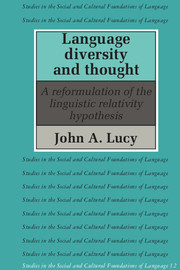Book contents
- Frontmatter
- Contents
- List of figures
- Acknowledgments
- Introduction
- 1 Development of the linguistic relativity hypothesis in America: Boas and Sapir
- 2 Development of the linguistic relativity hypothesis in America: Whorf
- 3 Approaches in anthropological linguistics: typical ethnographic case studies
- 4 Approaches in anthropological linguistics: theoretical and methodological advances
- 5 Approaches in comparative psycholinguistics: experimental studies on the lexical coding of color
- 6 Approaches in comparative psycholinguistics: experimental studies on grammatical categories
- 7 Overview and assessment of previous empirical research
- Notes
- References
- Index
5 - Approaches in comparative psycholinguistics: experimental studies on the lexical coding of color
Published online by Cambridge University Press: 05 June 2012
- Frontmatter
- Contents
- List of figures
- Acknowledgments
- Introduction
- 1 Development of the linguistic relativity hypothesis in America: Boas and Sapir
- 2 Development of the linguistic relativity hypothesis in America: Whorf
- 3 Approaches in anthropological linguistics: typical ethnographic case studies
- 4 Approaches in anthropological linguistics: theoretical and methodological advances
- 5 Approaches in comparative psycholinguistics: experimental studies on the lexical coding of color
- 6 Approaches in comparative psycholinguistics: experimental studies on grammatical categories
- 7 Overview and assessment of previous empirical research
- Notes
- References
- Index
Summary
Introduction
The relationship between language diversity and thought did not receive a significant amount of research attention from psychologists until the 1950s, with the emergence of the subdiscipline of psycnolinguistics. Although this increased interest in language within psychology can be traced in large part to Whorf's work, actual studies of the cognitive significance of linguistic diversity have represented a relatively small portion of the total research effort. This is consistent both with a general tendency on the part of psychologists to avoid intercultural comparison and with a specific reluctance to cope with the full complexity of linguistic structure and diversity. The tradition is also marked by a strong concern with experimental assessment of individual cognition, and all the studies in this tradition compare some feature of one or more languages with the behavioral patterns of a sample of speakers on tasks designed to reveal cognitive processes.
These psycholinguistic studies can be divided into two broad groups: those involving the significance of lexical codability – to be dealt with in this chapter – and those involving the significance of some aspect of grammar such as form classes or logical relators – to be dealt with in the next. By far the majority of the studies fall into the lexical group, and the majority of these, in turn, concern the significance of color terms for cognition. These studies of the lexical encoding of color will be the focus of this chapter.
- Type
- Chapter
- Information
- Language Diversity and ThoughtA Reformulation of the Linguistic Relativity Hypothesis, pp. 127 - 187Publisher: Cambridge University PressPrint publication year: 1992



